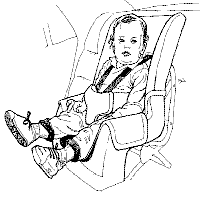| Transportation
of Children
Traffic accidents
or automobile crashes are one of the most common causes of injury and
death for children. You should pay particular attention to preventing
vehicle injuries.

- Always
use an approved car seat for any child under 40 lbs. Continue to use
the car seat until the child outgrows it. All other child and adult
passengers should use seat belts and harnesses. For more information
on national child safety seat requirements, call the National Highway
Transportation Safety Administration’s Auto Safety Hotline, 1-800-424-9393.
- Only allow
a vehicle to be operated by a person with a valid driver's license for
that type of vehicle.
- Never
allow anyone to operate a vehicle under the influence of alcohol or
drugs, including prescription drugs that may make a person drowsy.
- Make sure
that any vehicle used to transport children is licensed and registered
according to state laws.
- Equip
each vehicle with a first aid kit and emergency identification and contact
information for all the children being transported.
- Properly
maintain each vehicle.
- Air condition
a vehicle when the temperature is above 75°F; heat it when the temperature
is below 50°F.
- Never
allow smoking or playing audio equipment loudly in a vehicle when transporting
children. A driver should never use earphones while driving.

- Have enough
providers present to make sure that proper child-to-provider ratios
are maintained. Do not count the driver as a provider. A driver is not
able to properly supervise children while driving.
- Never
leave a child unsupervised in a vehicle.
- Carefully
supervise children getting in or out of a vehicle to avoid injury. Upon
boarding, make sure each child is properly buckled in. Upon exiting,
make sure each child is clear of the path of the vehicle and any other
traffic.
- Before
leaving the vehicle, check to make sure that all children have exited.
|